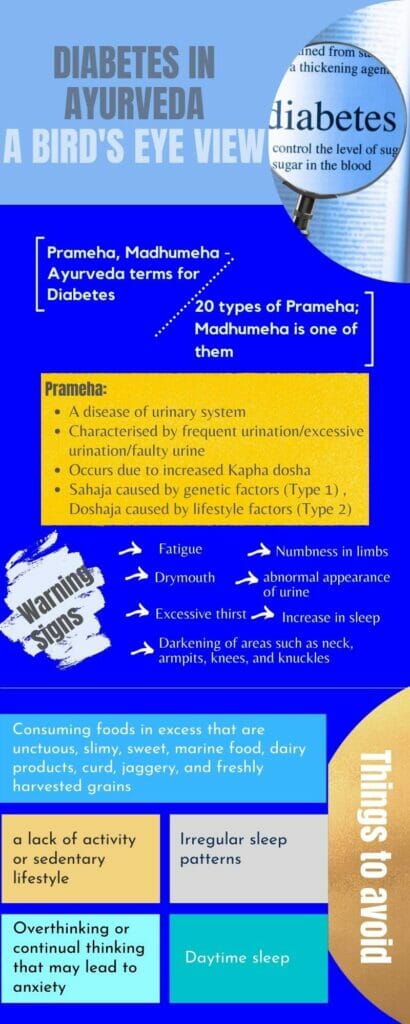Have you ever wondered about the origin of the term Diabetes Mellitus? If you thought it is English, you are wrong. The term was coined in an Egyptian manuscript around 1500 BCE. Diabetes means siphon, which means passing urine in excessive amounts. Around the same period, the ancient Indian medicine system Ayurveda classified a similar disease by the name Madhumeha which means Sweet urine.
So, now you know, though there has been a huge surge of diabetes cases only in the past few decades, Diabetes Mellitus is not a new disease. It has existed as early as 3500 years ago, and the ancient medicine of Ayurveda has mentioned the symptoms and treatment methods for diabetes in the Ayurvedic texts.
According to the World Health Organization, 71% of all deaths worldwide are due to non-communicable diseases, and diabetes mellitus is one such disease. Ayurveda always emphasises the prevention of diseases. Thus, by being aware of the symptoms and following Ayurvedic guidelines, one can prevent the onset of diabetes. Also, type 2 diabetes can be cured completely with the various effective Ayurveda treatment methods when you approach an expert at the early stages of the disease.
This article is a bird’s eye view of Diabetes in Ayurveda.
Ayurveda And Diabetes Mellitus
As you may know, Diabetes Mellitus is a group of metabolic disorders with characteristics of hyperglycemia. Marked by high glucose in the blood, the condition occurs due to defects in insulin production, insulin action, or both.
Why is diabetes a complex disease? Because the metabolic disorder associated with diabetes causes pathophysiological changes in multiple organ systems, thus making it very difficult to treat. An uncontrolled or untreated diabetes mellitus can damage the nervous system, eyes, renal system, and other bodily functions.
“In Ayurveda, the two terms commonly used in the context of Diabetes Mellitus are Prameha and Madhumeha. There are 20 types of Prameha; Madhumeha is one of them and is compared to modern science’s Diabetes Mellitus.“
Prameha
What is it?
Prameha is a disease of the urinary system. It is characterised by increased Kleda (liquid) causing excessive urination, frequent urination, or faulty urine. So, if you see an Ayurveda doctor at this stage, there is a huge probability of curing Prameha in its initial stage so that it does not progress to Madhumeha (diabetes).
Prameha can be Sahaja (congenital) or Doshaja (acquired). Genetic factors cause the first one, and lifestyle factors cause the second one. Thus, Sahaja causes Type 1 diabetes, and Doshaja causes Type 2 diabetes. While type 1 cannot be cured but treated and maintained, type 2 can be cured by Ayurveda.
Why does it occur?
As with all diseases, Prameha also occurs when there is an imbalance in the Tridoshas. In Particular, Kapha dosha is aggravated. An increased Kapha dosha affects mamsa (flesh), meda (fat), udaka (lymphatic channels) etc., which cause the digestive fire to diminish. When digestion is impaired, it produces aama (toxins) that are eliminated through urine, hence, the increased kleda (urine) output.
All three doshas are dependent on each other, and impairment of one affects the other two as well eventually. In Prameha, too, this happens. The first to be impaired is Kapha, followed by Pitta, and then Vata. When Vata is finally damaged, your diabetes becomes extremely difficult to treat.
Prameha – Warning Signs To Watch For:
According to Ayurveda, Purvarupa are the symptoms that appear before the disease (premonitory signs/warning signs). It is like a warning bell that your body sends when there is some imbalance in the body.
Regardless of the disease, this is the best time to treat it since it has not progressed too far. As a result, the treatment will work better and stop the progression of the disease.
Here are some Premonitory symptoms of Prameha (Diabetes mellitus)
- Abnormal appearance of urine
- Excessive sweetness in the mouth
- Numbness in the limbs
- Dry mouth
- Excessive thirst
- Fatigue
- Increase in sleep
- Lethargy
- Darkening of areas such as neck, armpits, knees, and knuckles
Suppose you are experiencing any of the above symptoms. In that case, you must visit an Ayurveda physician as soon as possible.
Also Read: 10 Sure-Shot Ways To Manage Your Blood Sugar Levels Naturally!
Symptoms of Diabetes mellitus according to Ayurveda
The following are the symptoms that occur after Prameha sets in. In other words, when you experience the below-mentioned symptoms, it means the disease has started progressing.
The common symptoms are:
- Polyuria- Increase in frequency of urine
- Polydipsia- Excessive thirst
- Polyphagia- Excessive hunger
- Unusual weight gain or loss
- Dry mouth
- Frequent infection
- Itching over the skin
- Slow healing of sores
- Excessive sweating
How does Ayurveda diagnose Diabetes?
In Ayurveda, there is no typical test in practice for identifying Madhumeha. However, Ayurvedic texts mention Mutra Pariksha, i.e. Urine examination, where if the individual’s urine attracts ants or flies, it implies that an individual is suffering from Madhumeha. Thus, it is like a diagnostic test in ancient times.
Nowadays, the diagnosis is based on the symptoms mentioned above and a blood sugar test such as Fasting Blood Sugar test, Random Blood Sugar test, or HBA1C.
How does Ayurveda treat diabetes?
The management of Prameha or Diabetes mellitus involves various treatment procedures with a long course of duration. The Ayurveda doctor treats Prameha by identifying the underlying cause, analysing manifestations and managing and curing symptoms.
The following are the treatment methods used in combination based on the assessment of the disease progression in a person.
Nidana parivarjana (avoiding causative factors)
One of Ayurveda’s core beliefs is to treat a disease by identifying the causative factors and eliminating them. The factors that cause Prameha include:
- Consuming foods in excess that are unctuous (buttery), slimy, sweet, marine food, dairy products, curd, jaggery, and freshly harvested grains
- a lack of activity or sedentary lifestyle
- Irregular sleep patterns
- Daytime sleep
- Overthinking or continual thinking that may lead to anxiety
Panchakarma
The therapies of Panchakarma intend to purify your biological system that helps treat diseases. Therapies for managing diabetes mellitus include Udvartana (powdered massage), Abhyanga (oil massage), Bashpa Sweda (sudation therapy), Vamana, Virechana, and Basti.
Oral medications
Ayurveda offers many herbs and formulated medicines that can ease the symptoms of diabetes mellitus.
- Single herbs: Some of the single herbs that have been in use for centuries include Amalaki (Indian gooseberry), Haridra (Turmeric), Methika (Fenugreek), Neem, Jambu (Indian blackberry), etc.
- Ayurveda medicines: Formulated medicines such as Chandraprabha Vati, Triphala Churna, Gokshuradi Guggulu, Phalatrikadi Kwath, and Lodhrasava help manage diabetes mellitus under Ayurvedic physician guidance.
Bottom Line
Prameha or Diabetes mellitus is a serious health concern that needs comprehensive management and preventative measures to handle its progression. The progression of Diabetes mellitus differs from person to person.
It is crucial to engage in Ayurveda treatment once symptoms have shown. With the help of Ayurveda treatment, you can protect your body from further complications of Diabetes mellitus but also engage in healthy living.
Edited by love4wellness | Images: canva.com

